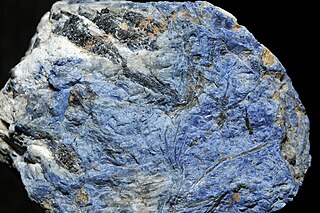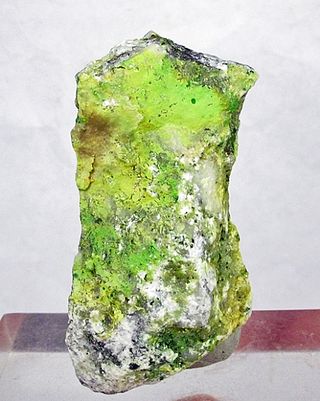
Zoisite, first known as saualpite, after its type locality, is a calcium aluminum hydroxy sorosilicate belonging to the epidote group of minerals. Its chemical formula is Ca2Al3(SiO4)(Si2O7)O(OH).

Forsterite (Mg2SiO4; commonly abbreviated as Fo; also known as white olivine) is the magnesium-rich end-member of the olivine solid solution series. It is isomorphous with the iron-rich end-member, fayalite. Forsterite crystallizes in the orthorhombic system (space group Pbnm) with cell parameters a 4.75 Å (0.475 nm), b 10.20 Å (1.020 nm) and c 5.98 Å (0.598 nm).

Cotunnite is the natural mineral form of lead(II) chloride (PbCl2). Unlike the pure compound, which is white, cotunnite can be white, yellow, or green. The density of mineral samples spans range 5.3–5.8 g/cm3. The hardness on the Mohs scale is 1.5–2. The crystal structure is orthorhombic dipyramidal and the point group is 2/m 2/m 2/m. Each Pb has a coordination number of 9. Cotunnite occurs near volcanoes: Vesuvius, Italy; Tarapacá, Chile; and Tolbachik, Russia.

Tellurite is a rare oxide mineral composed of tellurium dioxide (TeO2).

Bournonite, also axotomous antimony glance, wheel ore, berthonite, volchite or dystomic glance (German: antimonbleikupferblende) is a sulfosalt mineral species, trithioantimoniate of lead and copper with the formula PbCuSbS3.

Dumortierite is a fibrous variably colored aluminium boro-silicate mineral, Al7BO3(SiO4)3O3. Dumortierite crystallizes in the orthorhombic system typically forming fibrous aggregates of slender prismatic crystals. The crystals are vitreous and vary in color from brown, blue, and green to more rare violet and pink. Substitution of iron and other tri-valent elements for aluminium result in the color variations. It has a Mohs hardness of 7 and a specific gravity of 3.3 to 3.4. Crystals show pleochroism from red to blue to violet. Dumortierite quartz is blue colored quartz containing abundant dumortierite inclusions.

Stephanite is a silver antimony sulfosalt mineral with formula: Ag5SbS4. It is composed of 68.8% silver, and sometimes is of importance as an ore of this metal.

Loellingite, also spelled löllingite, is an iron arsenide mineral with formula FeAs2. It is often found associated with arsenopyrite (FeAsS) from which it is hard to distinguish. Cobalt, nickel and sulfur substitute in the structure. The orthorhombic lollingite group includes the nickel iron arsenide rammelsbergite and the cobalt iron arsenide safflorite. Leucopyrite is an old synonym for loellingite.

Enargite is a copper arsenic sulfosalt mineral with formula Cu3AsS4. It takes its name from the Greek word enarge, "distinct". Enargite is a steel gray, blackish gray, to violet black mineral with metallic luster. It forms slender orthorhombic prisms as well as massive aggregates. It has a hardness of 3 and a specific gravity of 4.45.

Warwickite is an iron magnesium titanium borate mineral with the chemical formula (MgFe)3Ti(O, BO3)2orMg(Ti,Fe3+, Al)(BO3)O. It occurs as brown to black prismatic orthorhombic crystals which are vitreous and transparent. It has a Mohs hardness of 3 to 4 and a specific gravity of 3.36.

Libethenite is a rare copper phosphate hydroxide mineral. It forms striking, dark green orthorhombic crystals. It was discovered in 1823 in Ľubietová, Slovakia and is named after the German name of that locality (Libethen). Libethenite has also been found in the Miguel Vacas Mine, Conceição, Vila Viçosa, Évora District, Portugal, and in Tier des Carrières, Cahai, Vielsaim, Stavelot Massif, Luxembourg Province, Belgium.

Nyerereite is a very rare sodium calcium carbonate mineral with formula Na2Ca(CO3)2. It forms colorless, platey pseudohexagonal orthorhombic crystals that are typically twinned. It has a specific gravity of 2.54 and indices of refraction of nα=1.511, nβ=1.533 and nγ=1.535. Nyerereite is not stable in contact with the atmosphere and rapidly breaks down. Collection specimens must be kept in a sealed argon environment.

Hessite is a mineral form of disilver telluride (Ag2Te). It is a soft, dark grey telluride mineral which forms monoclinic crystals.
Rhomboclase is an acidic iron sulfate mineral with a formula reported as H5Fe3+O2(SO4)2·2(H2O) or HFe(SO4)2·4(H2O). It crystallizes in the orthorhombic system and typically occurs as tabular crystals with a rhombic outline. It occurs as transparent colorless, blue, green, yellow or grey crystals with a vitreous to pearly luster.

Xocomecatlite is a rare tellurate mineral with formula: Cu3(TeO4)(OH)4. It is an orthorhombic mineral which occurs as aggregates or spherules of green needlelike crystals.

Gedrite is a crystal belonging to the orthorhombic ferromagnesian subgroup of the amphibole supergroup of the double chain inosilicate minerals with the ideal chemical formula Mg2(Mg3Al2)(Si6Al2)O22(OH)2.

Plancheite is a hydrated copper silicate mineral with the formula Cu8Si8O22(OH)4•(H2O). It is closely related to shattuckite in structure and appearance, and the two minerals are often confused.
Jonesite is a mineral with the chemical formula Ba4(K,Na)2[Ti4Al2Si10O36]*6H2O. This mineral is named after Francis Tucker Jones (1905–1993), who discovered the mineral while working as a Research Chemical Microscopist at Berkeley in CA. Jonesite has diffraction symmetry of mmm, which implies an orthorhombic system with all three axes perpendicular to each other and the angles between each axis equal to 90 degrees. In addition to symmetrical properties, Jonesite is a biaxial mineral with birefringence, which is a term to describe the difference between index of refraction. Jonesite is anisotropic, meaning the speed of light changes through the mineral, so the mineral shows color when viewed in crossed polarized light under a microscope. The mineral also has medium relief, which is a measure of how well the mineral stands out when viewed under a microscope in plane polarized light. In addition to being one of the rarest minerals in the Benitoite Gem mine located in California, Jonesite also is the first titanosilicate mineral with a porous double-layered crystal structure. This discovery is important because titanosilicate frameworks have industrial uses in energy companies and are used in containing radioactive waste.

The silver antimonide mineral dyscrasite has the chemical formula Ag3Sb. It is an opaque, silver white, metallic mineral which crystallizes in the orthorhombic crystal system. It forms pyramidal crystals up to 5 cm (2.0 in) and can also form cylindrical and prismatic crystals.

Stibarsen or allemontite is a natural form of arsenic antimonide (AsSb) or antimony arsenide (SbAs). The name stibarsen is derived from Latin stibium (antimony) and arsenic, whereas allemonite refers to the locality Allemont in France where the mineral was discovered. It is found in veins at Allemont, Isère, France; Valtellina, Italy; and the Comstock Lode, United States; and in a lithium pegmatites at Varuträsk, Sweden. Stibarsen is often mixed with pure arsenic or antimony, and the original description in 1941 proposed to use stibarsen for AsSb and allemontite for the mixtures. Since 1982, the International Mineralogical Association considers stibarsen as the correct mineral name.


















